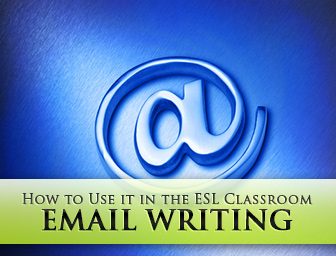How to Use Email Writing in the ESL Classroom


Of course, we’re responsible for teaching the correct grammar and vocabulary, but effective email writing is so much more than that. It is just as important to teach students how to be respectful and set the right tone. Here are 9 tips that will help your students write effective, professional emails - every time!

The subject line indicates what the email is about, and so it gives the recipient a certain idea of what to expect. The subject line is crucial because it often determines whether the email will be read or sent directly to the trash.
Students must understand that the subject line should be clear, descriptive and rarely include a complete sentence - unless it is absolutely necessary. A good rule of thumb is to keep it to no more than 50 characters. Also, it’s good to convey how personal and timely your message is. Here are some examples of effective subject lines you can give your students:
A lot of people are wary of attachments. They may take time to open, may contain a virus, or may require a program your recipient does not have. Students should only include attachments that they deem to be absolutely necessary and relevant to the email. It’s advisable for them to include some reference to the attached document within the main body of text (“Please find attached…”; “you’ll find the report attached”).
This is a common mistake with those who are inexperienced at sending professional emails. When you send an email to someone, it is not absolutely necessary to ‘cc’ (send a copy to) your boss or other members of the team every time. Students must learn to judge if it is necessary to send a copy of the email to someone else in addition to the main recipient.
Students should learn to state the purpose of their email early on (“I’m writing to let you know that….”). This gives a clear indication to the recipient whether it is something urgent that requires immediate attention or something that can wait. Any personal messages, holiday greetings or best wishes should be mentioned at the end of the email after business has been taken care of.
People are busy and often have inboxes flooded with emails. Students must understand that writing an email is not like writing a letter. Sentences should be shorter, just like paragraphs – ideally no more than five lines. If the email is turning out to be too long and complicated, it’s a good indication they should call this person instead.
This is not the time for students to show off their literary skills and all of the fancy words they’ve learned in ESL class. Although we teach students to use phrasal verbs in spoken English and more literary terms in written English (consider the use of “put off” vs. “postpone” or “put up with” vs. “tolerate”), they should stick to the simpler phrasal verbs in emails – unless it is a very formal one. In general, it is better to use simpler language to go with the shorter sentences and avoid words like “henceforth”, “acknowledge receipt of” or “in the event of”.
Students, particularly those who are young and inexperienced are often unaware of the fact that writing in capital letters IS LIKE SHOUTING in email language. Tell students that the best way to emphasize a date or hour, or any particular piece of information is by making it bold.
The subject of abbreviations is not as simple as it may seem – students must often use their own judgment as to which they should use. There are some that are used very often in Business English, like ASAP or FYI, but these are of standard use. Make sure students learn to differentiate business abbreviations from those that are more informal, like those used in text messages or SMS. Moreover, they must be sure recipients will be able to understand the abbreviation. When in doubt, it’s better to spell it out. They should also be used sparingly – just a couple per email. An email filled with abbreviations may just be too hard to decipher.
In addition to the usual closing (Regards, Sincerely, etc…) encourage students to add a more complete email signature that includes phone, email or other relevant contact info. It will give their emails a more professional touch.
If you have any other professional email writing tips that you usually share with your students, be sure to share them below as well!
And be sure to check out more email writing resources here!